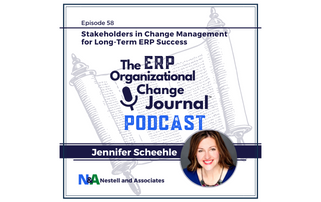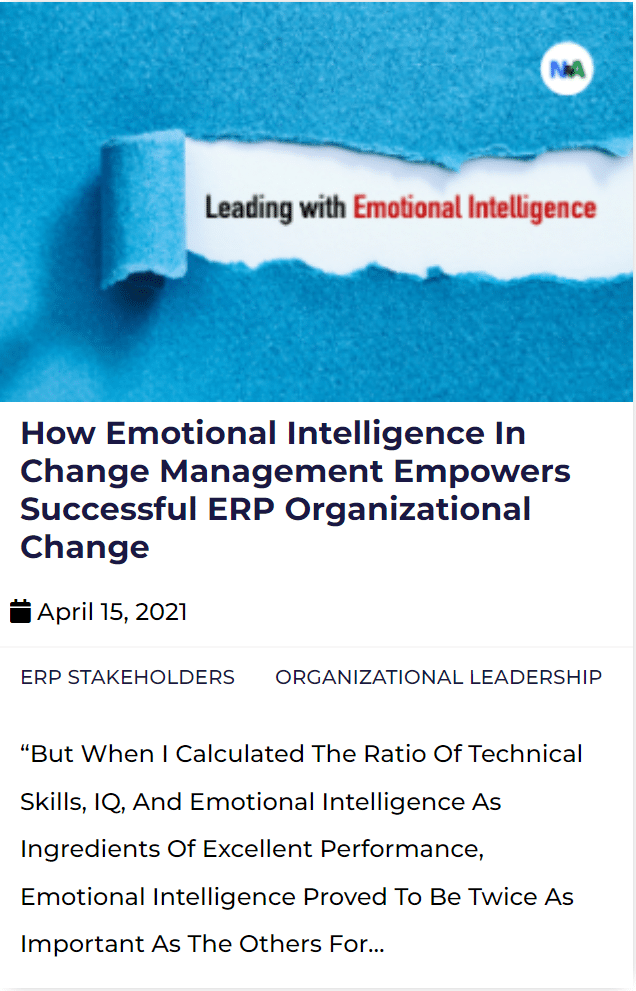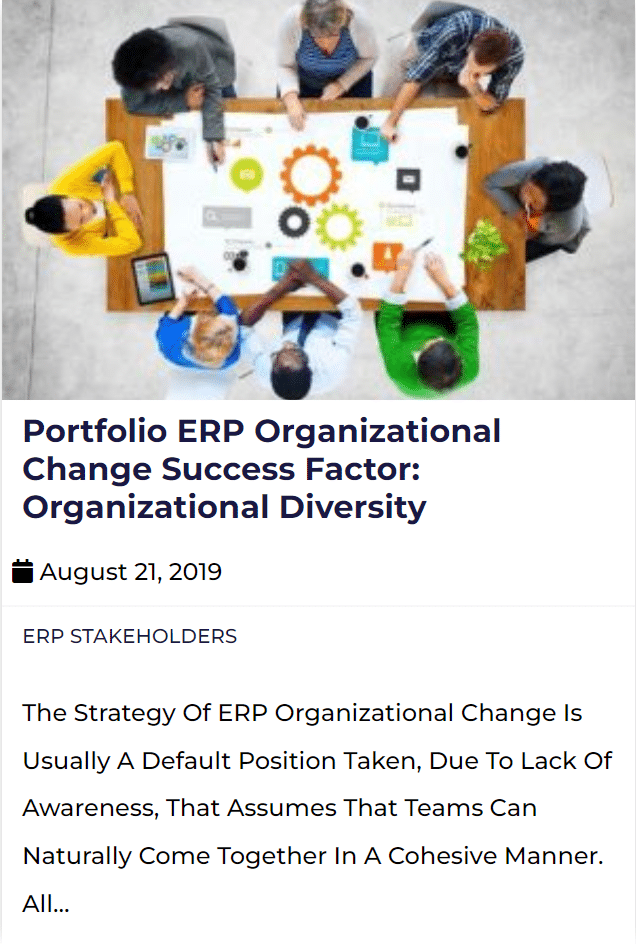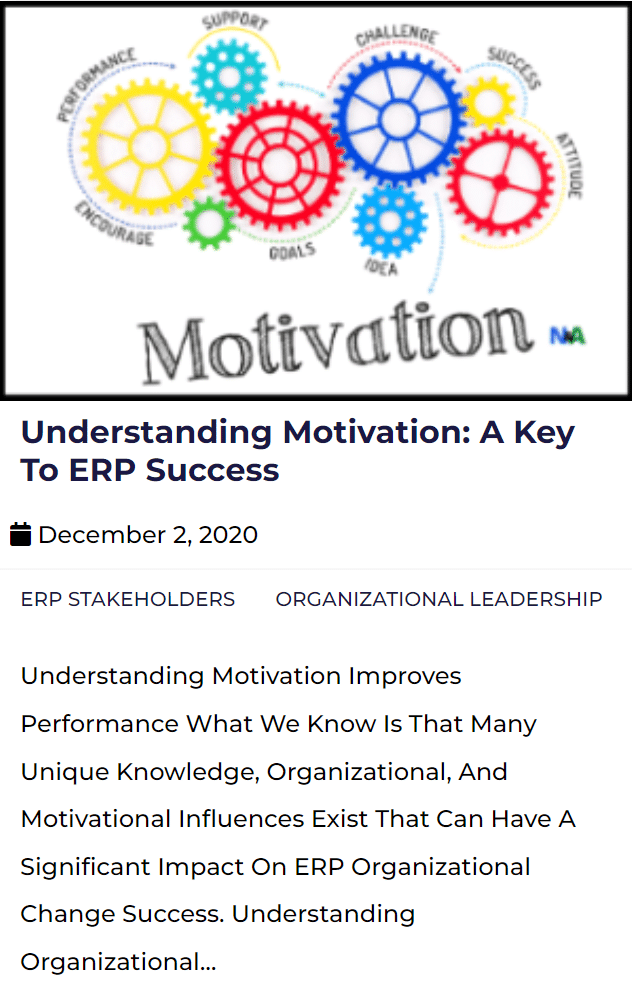- The Stakeholder Group Challenge
- Leading Effective Management of Stakeholder Diversity
- Manage Stakeholder Diversities with Organizational Change Models
- Manage Stakeholder Diversities with Effective Communication
- Manage Stakeholder Diversities by Understanding What Drives the Diversity and Relationships
- Manage Stakeholder Diversities by Understanding the Basic Principles of Stakeholder Theory
- Manage Stakeholder Diversities by Understanding what Drives Diversity and Relationships
“ERP-implementations challenge vested interests and lead to opposing views from various players. Implementation includes multi-level activities, which are not the exclusive area of a single project manager. Outcomes of decisions are not always products of rational considerations but shaped by the interests and commitments of individuals and groups, forces, and momentum.” Boonstra (2006), “Interpreting an ERP-implementation project from a stakeholder perspective.”
This article delves into the challenges and dynamics of stakeholder group diversity and relationships during ERP implementations. It discusses the significance of understanding these dynamics and provides practical strategies for managing stakeholder diversity effectively. As we navigate through the concepts of stakeholder theory, leadership awareness, effective communication, and organizational change models, we will gain valuable insights into how we can better manage and negotiate the complexities of ERP implementations.”
The Stakeholder Group Challenge: Navigating Stakeholder Diversity in ERP Implementation
Stakeholder group diversity as well as stakeholder group relationships often have a profound and significant impact on ERP organizational change. Furthermore, being unaware of and mismanaging stakeholder group diversities can manifest itself into a level of political turmoil. Multiple stakeholder groups often exist in any large-scale ERP project that has varying degrees of influence on the organizational change effort.
The relationships and roles of each level are important to understand because it helps explain and sheds insight on how to best manage the challenges of organizational change. As Lewis (2011) states, the challenge is that goals are likely to be held differently by different stakeholder groups and that goals within stakeholder groups are dynamic and can change over time.
Boonstra (2006) supports this notion by adding “ERP-implementation is a dynamic process, which means that views, which are held by stakeholders at one point in time, may change during the project. This may depend on various reasons, including cognitive, political, and opportunistic ones”.
This provides a challenge in organizational change because stakeholders are essentially able to rewrite history and also persuade themselves, and others, that the real goals (the current goals) existed from the onset of the project (Lewis, 2011). Lewis (2007) also notes that interactions, good or bad, among stakeholders, are influenced by assessments of each other and stakeholders’ concerns about change.
Significant diversity among stakeholders groups can contribute to significant misunderstandings and misalignment. A key point is that within any given organizational change effort, stakeholder interactions deserve careful understanding and consideration in an effort to provide corrections and effective communication that is in the best interest of all the stakeholders.
Leading Effective Management of Stakeholder Diversity
Effective stakeholder group reflection and management is an absolute key influence of organizational change. Therefore, understanding the value of, techniques, and mechanisms for managing stakeholder group diversity and relationships is crucial. Nordin (2013) states that leaders within organizations incur great pressure as a result of organizational change driven by competitive factors. These competitive factors can be external but also internally driven. Regardless of the organizational change model deployed, an organization needs to be mindful and reflective on the fact that understanding and then effectively managing stakeholder dynamics is a crucial part of any ERP organizational change plan.
Manage Stakeholder Diversities with Organizational Change Models
In order to minimize stakeholder group diversities and to improve and promote stakeholder group relationships, start with an organizational change model rooted in principle.
Often, as Gilley, Gilley, and McMillian (2009) state, group, and individual acceptance rates of organizational change adaption vary. This is because the individual or group’s adoption of the change is contingent upon the perception of the degree of the change (Gilley, Gilley, & McMillian, 2009).
Not only are there multiple and often diverse stakeholder groups, but to complicate matters, each group often also has its own strata as described by Gilley, Gilley, and McMillian which includes innovators, early adopters, early majority, late majority, and laggards.
As a result, organizational stakeholder dynamics can be quite complex making effective organizational change a challenge in any environment. All legitimate models of organizational change are intended to assist leaders through an effective process (Gilley, Gilley, & McMillian, 2009).
One such organizational change model is Kotter’s Eight-Step Model. This model articulates and emphasizes some of the incredibly important influences behind successful organizational change such as communicating the vision, forming coalitions, creating short-term wins, and creating a positive corporate culture.
And I would layer in another key influence and emphasize the idea from Lewis (2007), to minimize negative politics that can often exist between each stakeholder group. Effective organizational change approaches and models bring awareness to and include tangible mechanisms that help address and advocate for positive stakeholder group relations (especially through effective communication).
An effective organizational change model founded in principle offers organizations and practitioners guidance on the practical application of an effective process that addresses stakeholder group diversities and relationships.
Actionable Tips: Managing Stakeholder Diversities with an Organizational Change Model
- Choose an Organizational Change Model: Familiarize yourself with different organizational change models such as Kotter’s Eight-Step Model. Choose the one that fits your organization best.
- Understand the Model: Study the model in depth. Understand each step and its purpose.
- Apply the Model: Apply the model to your ERP implementation process. Ensure you’re not just going through the motions, but truly applying each step’s principle.
- Review and Adjust: Periodically review how well the model is working in your specific situation. Adjust as necessary.
Manage Stakeholder Diversities with Effective Communication
Due to the impact of stakeholder diversity and relationships upon organizational change, effective organizational communication is a critical tool. An effective communications strategy needs to effectively and specifically address stakeholders’ concerns, interactions, and ultimately outcomes for change (Lewis, 2007). In the ERP organizational change practice, stakeholder dynamics include disparate ideas of expectations, organizational change realities, and significant diversity in terms of knowledge, value, and motivation. Therefore, the interaction and management of communication between stakeholders are critical.
One actionable item as noted in Olding (2013) is to be mindful that effective stakeholder communication is bottom-up, top-down, and middle-out. That is, communication is not just something to be pushed down from the top. In particular, in communicating about organizational change it is important to reflect on two points; fear of the unknown and uncertainty and lack of choice (Denning, 2005). Effectively communicating how the change is intended to drive positive outcomes and results is key.
Sharing a consistent message but tailoring that message delivery for each stakeholder group is effective. That is, speak the language of that group. Tell the group the value of change in terms of what matters to them.
Actionable Tips: Managing Stakeholder Diversities with Effective Communication
- Create a Communication Plan: Clearly outline what needs to be communicated, to whom, when, and through what channels.
- Tailor Your Message: Understand the unique needs and concerns of each stakeholder group. Tailor your communication to address these specifics.
- Two-Way Communication: Ensure your communication allows for feedback. This encourages stakeholder alignment and engagement and allows you to address concerns promptly.
- Review and Adjust: Regularly assess the effectiveness of your communication and make adjustments as needed.
Manage Stakeholder Diversities by Understanding What Drives Diversity and Relationships
Effectively understanding stakeholder group diversity in its many forms and relationships is a concept that is of great importance. Many times, individuals in a group are simply following the lead of others in their group. Lewis (2005) explains that individual connections and influences have a profound influence on how an individual reacts to supporting a change effort. In other words, understanding stakeholder group dynamics among and throughout all stakeholder groups can help minimize the impact of individuals reacting to change more as a “monkey see monkey do” response instead of through a clear understanding of the vision, value, and purpose of the change. Lewis (2011) notes that it is important to recognize that belonging to a specific stakeholder group alone can influence an individual’s support for or against the change.
What if that stakeholder group leader is simply a transactional mindset-oriented leader? Simply being more of a transformational leader would be more supportive of the organizational change endeavor. As supported by great work, a transformational leadership mindset is a significant influence in ERP organizational change.
Another point of Lewis (2011) that needs to be layered in when reflecting on stakeholder groups is the notion of salience by default (Lewis, 2011). For example, the introduction of a new computer system in a workplace might raise the salience of identities related to expertise or technological qualifications and lower the salience of that less technical savvy (Lewis, 2011).
Stakeholder group leader influence, sheer association with a stakeholder group, and salience by default are just three potential influences and important notions to be mindful of in terms of understanding stakeholder group diversities and relationships.
Manage Stakeholder Diversities by Understanding Basic Principles of Stakeholder Theory
This is an idea mentioned in previous posts but worth repeating. If one is to truly understand and support stakeholder group diversity and relationships and therefore improve organizational change, then stakeholder theory is critical to understand.
Stakeholder theory attempts to explain how organizations understand stakeholder groups and then strategically determine the action most effective at managing the relationships between those stakeholder groups (Lewis, 2011). In understanding how best to improve organizational change success, it is also important to layer in some ideas as discussed in Lewis (2011). These ideas are; understanding existing relationships with stakeholders, understating how organizational actions shape stakeholder relationships, and understanding the obligations of managers to various stakeholders. Stakeholders are constantly accessing the degree to which their interests are competitive or complementary with other stakeholders (Lewis, 2011). Organizational leadership would benefit to act as mediators, or “spanners” as noted by Lewis (2011), between stakeholder groups and encourage and help relationships between stakeholder groups…this is the premise of stakeholder theory.
Actionable Tips: Managing Stakeholder Diversities by Understanding Stakeholder Theory
- Educate Yourself: Familiarize yourself with the principles of stakeholder theory.
- Identify Your Stakeholders: Understand who your stakeholders are and what their interests and concerns might be.
- Apply the Theory: Use stakeholder theory to guide your actions in managing stakeholder relationships during the ERP implementation.
- Reflect and Learn: After the ERP implementation, reflect on what worked and what didn’t. Use these learnings for future projects.
Manage Stakeholder Diversities by Illuminating Hidden Aspects of Stakeholder Relationships
Stakeholder group diversity and relationship management is an often forgotten influences in many ERP organizational change efforts despite their significance. Furthermore, stakeholder group diversity and relationships are often the more abstract and intangible influence of ERP organizational change. But, the key lies in making that which is more subjective, intangible, and informal into something that is more formal, visible, and open for discussion and reflection. Boonstra says it well, “The case history clearly illustrates that different stakeholders can interpret ERP systems in different ways, given their own histories, interests, self-images, prospects, and views. Some groups perceive the system as a means to realize certain new company-wide objectives, while others see the system as a way to regain lost power or as a threat to legitimate local interests. So, the case study shows how these different interpretations may easily lead to differences in priorities and ways of implementation. These differences are not all clear at the start and are not all expressed and discussed during formal meetings” (Boonstra, 2006).
Understanding and reflecting upon the notion of stakeholder group diversities and relationships and then addressing them in a meaningful, productive, and concrete way is a valuable ERP organizational change practice.
Concluding Insights on Managing Stakeholder Diversity in ERP Organizational Change
In conclusion, navigating the complexities of stakeholder diversity and relationships is crucial for successful Enterprise Resource Planning (ERP) organizational change. Leaders are urged to understand these dynamics deeply and to employ effective strategies, such as principled change models, effective communication, and the principles of stakeholder theory. By bringing the often intangible aspects of stakeholder relationships into the light, organizations can pave the way for meaningful dialogue and reflection, ultimately leading to a more successful and inclusive transformation process.
Don’t let stakeholder challenges hinder your success. Engage with the ERP Experts at Nestell & Associates
Navigating the complexities of stakeholder diversity in ERP implementation is a challenge. The team at Nestell & Associates are here to help. We offer tailored strategies and insights to make your ERP transition as smooth as possible. Your successful ERP implementation is just one step away. Contact us now.
References:
- Boonstra, A. (2006). “Interpreting an ERP-implementation project from a stakeholder perspective.” International Journal of Project Management 24(1): 38-52.
- Denning, S. (2005). The leader’s guide to storytelling: Mastering the art and discipline of business narrative (Vol. 269). San Francisco, CA: Jossey-Bass.
- Gilley, A., Gilley, J. W., & McMillan, H. S. (2009). Organizational change: Motivation, communication, and leadership effectiveness. Performance Improvement Quarterly, 21(4), 75-94.
- Kotter’s Eight-Step Model: https://www.kotterinc.com/8-steps-process-for-leading-change/
- Lewis, L. K. (2011). Organizational change: Creating change through strategic communication (Vol. 4). Hoboken, NJ: John Wiley & Sons.
- Nordin, E. J. (2013). Exploring effective communication for organizational change (Unpublished doctoral dissertation). Walden University, Minneapolis, MN.
- Olding (2013) (“Communicating for Effective Organizational Change” from the Gartner Symposium in Spain)
- Ravanfar, M. M. (2015). Analyzing organizational structure based on 7s model of McKinsey. International Journal of Academic Research in Business and Social Sciences, 5(5), 43-55.
- Wheeler, D. S., Maria (1998). “Including the Stakeholders The Business Case.”
Dr. Jack G. Nestell
Related Podcast Episodes
Episode 58: Stakeholders in Change Management for Long-Term ERP Success
Related Articles
About Nestell & Associates
Merger and acquisition ERP digital transformations can be a significant challenge. But a solid framework is built on good practices with proven success. We have a successful track record with integrations, upgrades, mergers, and acquisitions, and we want to share our methods with you.
Our leadership experience in organizational change, information technology, ERP, and digital transformation crosses multiple industries.






